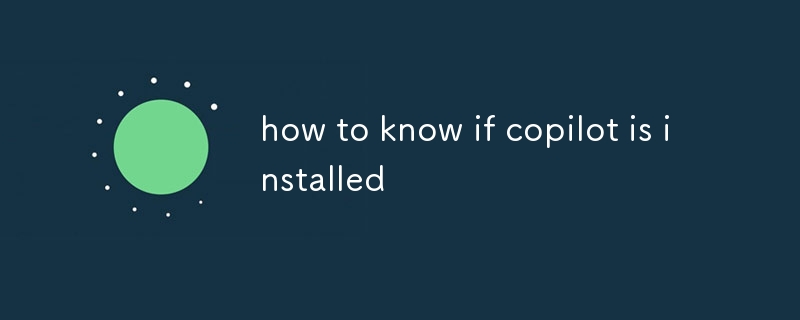Home >Technology peripherals >AI >how to know if copilot is installed
how to know if copilot is installed
- DDDOriginal
- 2024-08-19 10:42:19756browse
This article outlines methods to detect the presence of Copilot, a coding assistance tool. Visual cues, keyboard shortcuts, code snippets, and enhanced autocompletion may indicate its installation. To verify its activity, check editor/IDE settings, u

How to know if copilot is installed
What are the signs that copilot is installed on my system?
- Visual cues: Copilot's interface is typically integrated into the editor or IDE you are using. Look for a sidebar, panel, or floating window that provides suggestions and assistance.
- Keyboard shortcuts: Copilot often assigns keyboard shortcuts for common actions, such as generating code or completing a line. Check the documentation or settings of your editor/IDE to see if there are any copilot-related shortcuts.
- Code snippets: If you see code snippets appearing in your editor without you explicitly typing them, this is a strong indication that copilot is installed and active.
- Autocompletion: Copilot enhances the autocompletion functionality of your editor, providing more context-aware suggestions and even generating entire lines of code.
How can I verify if copilot is active and running on my device?
- Check the editor/IDE settings: Look for a dedicated section or option in the settings that allows you to enable/disable copilot or configure its behavior.
- Use a keyboard shortcut: Many editors/IDEs allow you to toggle copilot on/off using a keyboard shortcut. Try pressing the assigned key combination to see if it activates or deactivates copilot.
- Examine the process list: Open the task manager or activity monitor on your system and check if there is a process running with a name related to copilot. This process should be running even when you are not actively using copilot.
Are there any specific indicators that confirm the presence of copilot on my computer?
In addition to the signs mentioned above, here are some more specific indicators:
- Log files: Copilot typically generates log files or error messages that can help you troubleshoot issues or confirm its presence. Check the user logs or application logs for entries related to copilot.
- File extensions: Copilot may create or modify temporary files or directories with specific file extensions. For example, you might find files with extensions like ".codd" or ".copilotcache".
- Registry entries: On Windows systems, copilot may create entries in the Windows registry under specific keys or subkeys. Check the registry editor for keys related to copilot or its components.
The above is the detailed content of how to know if copilot is installed. For more information, please follow other related articles on the PHP Chinese website!
Related articles
See more- Technology trends to watch in 2023
- How Artificial Intelligence is Bringing New Everyday Work to Data Center Teams
- Can artificial intelligence or automation solve the problem of low energy efficiency in buildings?
- OpenAI co-founder interviewed by Huang Renxun: GPT-4's reasoning capabilities have not yet reached expectations
- Microsoft's Bing surpasses Google in search traffic thanks to OpenAI technology

